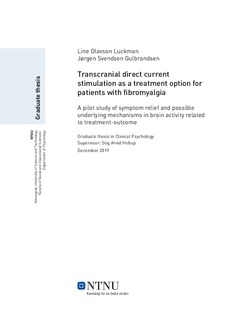Transcranial direct current stimulation as a treatment option for patients with fibromyalgia - A pilot study of symptom relief and possible underlying mechanisms in brain activity related to treatment-outcome
Master thesis
Permanent lenke
http://hdl.handle.net/11250/2641363Utgivelsesdato
2019Metadata
Vis full innførselSamlinger
- Institutt for psykologi [3108]
Sammendrag
Studies have shown an effect of transcranial direct current stimulation (tDCS) over the primary sensorymotor and motor cortex (S1/M1) on pain reduction. In this study, we investigated the effect of 5 consecutive sessions (20 minutes) of 2 mA anodal tDCS over M1 in 16 subjects with fibromyalgia (FM). Self-reported perception of pain, fatigue, and fibrofog were measured approximately 7 days before treatment, 7 days after treatment and at least 3 months after the end of treatment. Adverse effects were registered. Additionally, an EEG recording of the subjects was conducted to investigate possible deviances related to chronic pain before and after treatment in three conditions; eyes opened, eyes closed and VCPT. The qEEG patterns were hypothesised to be able to predict treatment-outcome with tDCS in subjects with FM. A significant reduction in pain, fatigue and fibrofog was observed in the treatment condition. Results indicate that tDCS may have a significant effect on pain reduction in subjects with FM, and that this effect is lasting over 3 months. The best outcome group, defined by the greatest symptom reduction on subjective measures, were found to have significantly less oscillatory correlates to default mode network activation in resting state compared to the worst outcome group, pre-treatment. The best outcome group were also found to have significantly more oscillatory correlates to default mode network activation in resting-state post-treatment. Further research should focus more specifically on the effects of tDCS within the framework of an RCT-design with a larger sample size.
